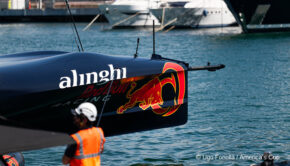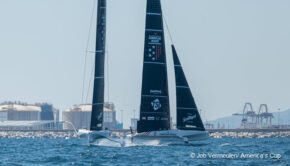How the prototype was born
Published on November 15th, 2022
The head of the Luna Rossa Prada Pirelli’s design team, Horacio Carabelli, coordinates a design pool consisting of 14 departments (naval architecture, mechatronics, structural engineering, VPP, simulator, etc.), each of which counts two to five people reporting to a HOD (head of department).
Each of these people works independently but is closely linked to the work of the others, so there is an uninterrupted flow of information between the various departments.
“Generally speaking”, explains Horacio Carabelli, “for the birth of any new racing boat, we start from the reference Rule and the prototype is no exception. In our case, since we could not build two AC75s, we had to choose the best way to do research and development.
“According to the Protocol of the 37th America’s Cup, in fact, the possibility of doing experimentation on the old AC75s or the new AC40 One Design is very limited, so we opted to build – here at the base in Cagliari – a LEQ12 (Less or Equal to 12m) prototype and we are very happy with the choice we made.
“When you design a boat, you have full control over it: from the rudders to the appendages to the sail plan and the management systems, you know how things work because you have designed and built them. It’s very different from modifying a boat that arrives ready-made and you know nothing because you don’t know its history”.
The design phase
For the prototype, they did not start from a blank sheet of paper: the experience gained in the previous America’s Cup – raced with the boat class (AC75) – was of great help to the team in the development of this project.
“We learned a lot from the last Cup, so the prototype condenses all the successful solutions that we have experimented over time”, continued the head of the design team.
“Once the Rules were published, we had to define the basic lines of the boat, so I met with the designers from the naval architecture, structural engineering, performance, VPP (Velocity Prediction Program) and simulator departments to understand what we wanted to achieve; we established the measurements, the shapes of the appendages and the dimensions, the rudders, the sail area, the displacement. All, in short, the preliminary technical characteristics of the boat”.
Simulation
Once this information is clear, you need to assess the weights, loads and feasibility of the designs, i.e. whether you can build these components exactly the way you designed them; at this point you introduce the first of the systems you want to test and from there you proceed to the simulator, which faithfully reproduces reality and also offers the possibility of simulating real sailing with (live) sailors on board.
“When you’re at the simulator stage», he continues, «you also have to make a good aerodynamic package and this is where the sail design department comes in, because all the sails have to be designed with the right shapes and loads; then you run a CFD (Computational Fluid Dynamics) complete with this package, and you create the aero model which, together with those of the appendages and naval architecture, flows into the simulator to see what the final product will look like. Only at this point can you be sure that the scale dimensions and decisions made are right and proceed to the next stage”.
Production
Next, you enter the third design cycle and can already start talking about production.
“When you get to production, the prototype will also serve as a testing platform because now other materials come into play, other people will be working on and producing these complex composite parts, but also new production techniques, so there is a constant flow of information between the structural engineering, design and 3D modeling departments, where all the systems and parts work together to create a final 3D virtual model.
“The work of the structural engineers is very important because AC75s are very light boats subjected to significant loads, especially in certain areas, and the displacement limit imposed by the regulations must be met, which is no easy challenge for the designers. That’s where the FEA (Finite Element Analysis) experts come in. They have a big responsibility in the analysis of the structures, and they also deal with the people in charge of the rig and the sails; it’s a very important part of the design process”.
As we all know, the AC75 is a foiling boat class, so the foils are one of the most important components of the whole package. Within Luna Rossa Prada Pirelli is a very experienced team dedicated to the appendages, the foil sections and also the structural part. The interaction with the sailors is fundamental to collect their feedback, both with respect to training in the simulator and at sea. The goal is to gather a great deal of information to reach a final boat-product that must be the best possible, since it is the only one that is allowed to be built.
“The design phase never ends”, explains Carabelli. “We work every day, from 08.00 in the morning until late at night, trying to refine, discover, correct and improve something all the time. We have a department meeting every 15 days to have a status and progress report and to make sure we keep to our schedule, but our work never ends.
“Up until the moment we have to deliver the configuration certificate, we have the opportunity to modify (within a certain limit) all the areas: hull, foil, sails, systems, etc., and we make the most of this possibility until the last minute in order to close any gaps or correct any weakness we may have noticed during training. That’s what all the teams do”.
The ‘Recon’ program: shared espionage
Taking cues from others is even easier, thanks to the Recon program. “Certainly, the ‘shared’ Spying Program allows you to see what teams are doing and share information; it is important to know what others are doing, and it is normal to take cues.
When we put our boat n.1 on the water in 2019 the other competitors copied many ideas, in fact their second and final hulls had many features migrated from Luna Rossa. You have to look everywhere and take whatever you think is interesting. Then, how you put these ideas together will make the difference between you and the others”, Carabelli added.
Following the publication of the AC37 Protocol and AC75 Class Rule on November 17, 2021, the AC75 Class Rule and AC Technical Regulations were finalized on March 17, 2022. The entry period opened December 1, 2021 and runs until July 31, 2022, but late entries for the 37th America’s Cup may be accepted until May 31, 2023. The Defender was to announce the Match Venue on September 17, 2021 but postponed the venue reveal, confirming it would be Barcelona on March 30, 2022. The 37th America’s Cup will be held in September/October 2024.
Teams revealed to challenge defender Emirates Team New Zealand (NZL):
• INEOS Britannia (GBR)
• Alinghi Red Bull Racing (SUI)
• Luna Rossa Prada Pirelli Team (ITA)
• NYYC American Magic (USA)
Noticeboard: https://ac37noticeboard.acofficials.org/
Additional details: www.americascup.com/en/home
Source: Luna Rossa Prada Pirelli









 We’ll keep your information safe.
We’ll keep your information safe.